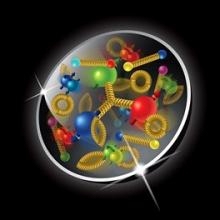
Prof. Salina Ali (Lafayette College) will give a colloquium in the Physics Department on the fundamental the srtucture of nucleons (protons and neutrons) and how to probe it using neutron-Deeply Virtual Compton Scattering. This lecture is open to the campus community, but assumes at least 1-2 years of physics background coursework. Come early for cookies and coffee with the Physics Club, starting at 4:15 PM!
Title: Towards 3D Imaging of the Nucleon
Abstract: Understanding the structure of the nucleon (proton or neutron) in terms of its most basic constituents, the quarks and gluons, is one of the main thrusts of twenty-first century physics research. Just as the earth orbits around the Sun while simultaneously spinning about its own axis, the quarks and gluons in a proton could have linear motion, orbital motion, and spin --- the latter two responsible for the overall proton spin that is exploited daily in thousands of MRI images worldwide. Experimentally, one cannot isolate the quarks and gluons, but one can infer their properties from experiments on nucleons. High-energy electron beam experiments leading to a final state of a completely-measured set of only a few particles allow to image the deep inside structure of the nucleon. This is the topic of a new science direction termed "nuclear femtography." In this talk, I will discuss exclusive reactions: processes in which the deep inside of the nucleon is studied with a highly-energetic electron probe by a completely-measured set of only a few particles, e.g. a neutral pion or photon. The upcoming Jefferson Lab Hall A spectator tagged physics program includes a measurement of exclusive tagged neutron-Deeply Virtual Compton Scattering (n-DVCS), shedding light on the neutron structure through the spectator tagging technique. This measurement will depend on a multi-Time Projection Chamber (mTPC) device used to detect low-momentum particle tracks in extreme high background rate conditions. I will describe the experimental setup in Hall A of Jefferson Lab, prospects of the n-DVCS measurement, and the status of the mTPC detector.


